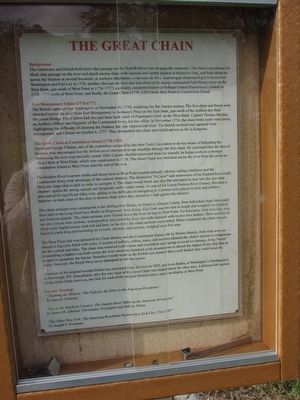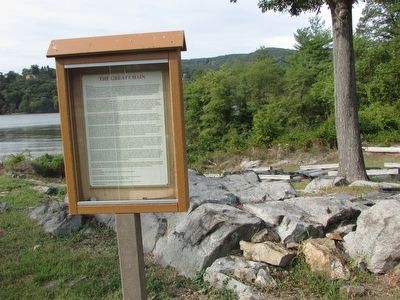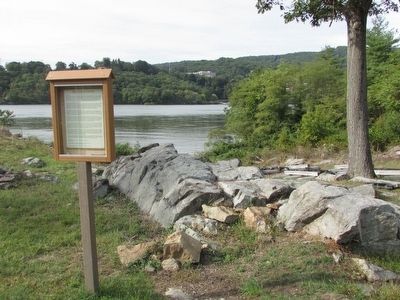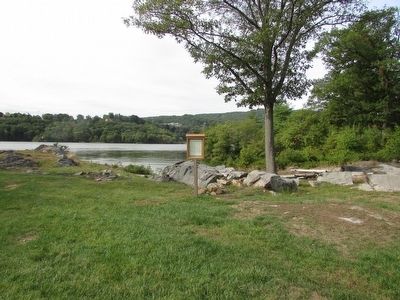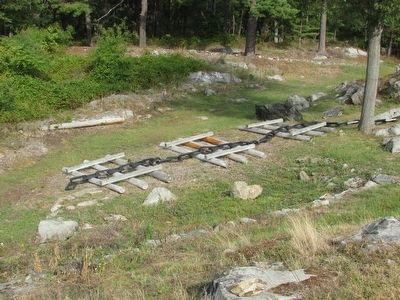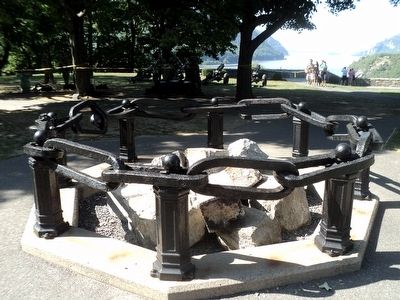Constitution Island in Philipstown in Putnam County, New York — The American Northeast (Mid-Atlantic)
The Great Chain
Background
The Americans and British both knew that passage on the Hudson River was strategically important. The Americans planned to block ship passage on the river and attack enemy ships with cannons and mortar located at defensive forts, and built obstacles across the Hudson at several locations: at northern Manhattan, a chevaux-de-frise (submerged sharpened logs) between Fort Washington and Fort Lee in 1776; another chevaux-de-frise and iron chain at the newly constructed Fort Montgomery on the West Bank, just south of West Point in 1776-1777; a partially completed barrier at Pollepel Island (Bannerman’s Island) in 1776-1777 north of West Point; and finally, the Great Chain (1778-1783) from West Point to Constitution Island.
Fort Montgomery Chain (1776-1777)
The British captured Fort Washington on November 16, 1776, rendering the first barrier useless. The first chain and boom were stretched across the river from Fort Montgomery to Anthony’s Nose on the East Bank, just north of the modern-day Bear Mountain Bridge. Fort Clinton had also just been built south of Popolopen Creek on the West Bank. Captain Thomas Machin, an Artillery Officer and Engineer of the Continental Army, led this effort. In November 1776, the chain broke under tidal stress, highlighting the difficulty of chaining the Hudson, but was repaired and reset. The British stormed and captured Forts Montgomery and Clinton on October 6, 1777. They dismantled this chain and raided upriver as far as Kingston.
The Great Chain at Constitution Island (1778-1783)
Governor George Clinton, one of the committee assigned by the New York Convention to devise means of defending the Hudson, was encouraged that the British never attempted to run warships through the first chain. He concluded that the idea of obstructing the river was basically sound. After Captain Machin recovered from his wounds, he began work on a stronger Great Chain at West Point, which was constructed in 1778. The Great Chain was stretched across the river from this point on Constitution Island to West Point until the end of the war.
The Hudson River’s narrow width and sharp turns at West Point created naturally adverse sailing conditions and the Continental Army took advantage of this natural obstacle. The distinctive “S-Curve” and narrowness of the Hudson here would force any large ship to tack in order to navigate it. The chain would block any ship that attempted to turn into the east-west channel against the strong current and frequently unfavorable winds. As part of the Lower Hudson River Estuary, this area is also subject to significant tides, only adding to the difficulty of navigating it. Cannons were placed in forts and artillery batteries on both sides of the river to destroy ships when they slowed to a halt against the obstacle.
The chain sections were constructed at the Stirling Iron Works, in Warwick, Orange County, from individual chain links made there and at the Long Pond Iron Works in Ringwood, New Jersey. Each link was two feet in length and weighed one hundred and fourteen pounds. The chain sections were floated down the river on logs to West Point. For buoyancy, forty-foot logs were cut into sixteen-foot sections, waterproofed, and joined by fours into rafts fastened with twelve-foot timbers. Short sections of chain were stapled across each raft and later, in the river, the chain sections were united. When completed, the chain was six hundred yards long and including its swivels, clevises, and anchors, weighed sixty-five tons.
The West Point side was protected by Chain Battery and the Constitution Island side by Marine Battery. Both ends were anchored to log cribs filled with rocks. A system of pulleys, rollers, ropes, and anchors adjusted the chain’s tension to compensate for the current and tides. The chain was removed each winter and reinstalled each spring to avoid ice damage. A log “boom” (resembling a ladder) was built across the river about one hundred yards downstream to absorb the impact of any ship that attempted to penetrate the barrier. Benedict Arnold wrote to the British and claimed that a well-loaded ship could break the chain. However, the Royal Navy never attempted to run the barrier.
A section of the original wooden boom was recovered from the river in 1855, and is on display at Washington’s Headquarters in Newburgh, NY. Immediately after the war, most of the Great Chain was melted down for other uses. A thirteen-link section of the Great Chain survives, one link for each of the original thirteen states, and is on display at West Point.
Further Reading:
“Chaining the Hudson: The Fight for the River in the American Revolution”
by Lincoln Diamant.
“Key to the Northern Country: The Hudson River Valley in the American Revolution”
by James M. Johnson, Christopher Pryslopski and Andrew Villani
“The Other New York: The American Revolution Beyond New York City, 17763-1787”
by Joseph S. Tiedeman
Topics. This historical marker is listed in this topic list: War, US Revolutionary.
Location. 41° 24.095′ N, 73° 57.103′ W. Marker is in Philipstown, New York, in Putnam County. It is on Constitution Island. Touch for map. Marker is in this post office area: Cold Spring NY 10516, United States of America. Touch for directions.
Other nearby markers. At least 8 other markers are within walking distance of this marker. Anna B. Warner Memorial Garden (within shouting distance of this marker); Marine Battery (within shouting distance of this marker); Revolutionary War Constitution Island (within shouting distance of this marker); Fortress West Point (within shouting distance of this marker); a different marker also named The Great Chain (within shouting distance of this marker); The Warner House (about 300 feet away, measured in a direct line); Fort Constitution Area (about 400 feet away); Hill Cliff Battery (about 400 feet away). Touch for a list and map of all markers in Philipstown.
Credits. This page was last revised on July 20, 2023. It was originally submitted on September 27, 2015, by Bill Coughlin of Woodland Park, New Jersey. This page has been viewed 1,474 times since then and 717 times this year. Photos: 1, 2, 3, 4, 5, 6. submitted on September 27, 2015, by Bill Coughlin of Woodland Park, New Jersey.
